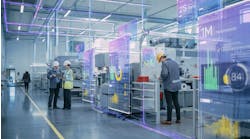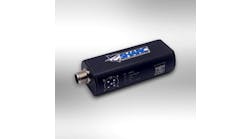Collaborative robots are all the rage. Learn why and how these mechanical marvels will benefit manufacturing applications. With robotics playing such a pivotal role in the future of discrete manufacturing, we asked a seasoned panel of industry for their insights and predictions on the role of robots.
Click here to meet the panel of experts.
Q: Collaborative robots eliminate the barrier between the working human and the robot, but what kinds of applications will actually benefit from collaborative robots?
Craig Souser: They need to be applications where the robot motion is relatively slow and not much mass is moving. Light-duty assembly and fixturing of a part for a human to interface to are good uses.
Carole Franklin: Collaborative robots may be best described as collaborative robot systems, rather than any particular type of robot. Collaborative robot systems are ones in which the robot and human worker have overlapping workspaces. However, it is probably not realistic to assume that all safeguarding barriers will go away tomorrow. For now, the collaborative workspace will most likely be a small defined space with familiar fencing or other safeguards surrounding the rest of the robot.
Melanie Cavalieri: There are a lot of traditional applications that come to mind when considering industrial applications, which are repetitive and physically demanding, such as assembly, loading/unloading, packaging, sorting, dispensing, sanding and polishing. These types of applications will continue to benefit as the adoption rates increase across a range of business sizes. Robots are no longer only for the large industrial manufacturers, and these businesses will see a wide range of benefits.
A large number of applications see a return on investment (ROI) in less than one year with today’s collaborative technology. In addition to the reduction of labor costs and the increase in productivity, these robots allow facilities to reduce assembly line sizes because they don’t require separate stand-alone, caged areas. Robots can be co-located to work directly next to their human counterparts, which means fewer barriers to work around and less lost time for people.
Finally, robots can work in the complex human environment without large installations of external sensors and barriers. This allows facilities to deploy robots, remove robots or deploy humans as required in the current working environment. This enables flexibility that is required by a lot of high-mix, low-volume manufacturing facilities.
Also read: The impact of wireless technology on presence sensors with robots
A collaborative, complex sensing robot not only allows a robot to work next to a human counterpart, but it also allows it to work in complex and dangerous applications that still would be difficult to deploy a traditional robot. Applications like painting or removing paint from large ships traditionally expose a person to dangers including chemicals and height. Now robots can be deployed to do this work without the overly complex task of installing guides, tracks or sensors.
Applications where we’ve seen automated equipment being used in large organizations can now be used with smaller organizations, with smarter and more accessible collaborative robots. Warehousing and logistics have been using AGVs for a number of years but traditionally require a large facility investment to allow these vehicles to operate. Mobile robots combined with articulated robots present an exciting new opportunity to have robots handle movement around a facility, as well as select and pack products, all while working in a human environment.
Finally, collaborative robots are providing an exciting opportunity in remote security and monitoring. This application combines a variety of technology including mobile robotics, sensing and video monitoring. Opportunities for these robots include country and state borders and other large, sprawling areas such as agricultural farms, solar farms, warehouses, airport parking lots or military bases.
David Arens: Collaborative robots by their name indicate that they will be working in a human environment. They are not eliminating the barrier between the working robot and the human; they are just changing the barrier between human and robot to be the surface of the robot and any manipulators or attachments.
This being said, the robots can assist humans in steadying the motion, for example, in surgery and or lab operations to prevent the human jerkiness and fine motor skills from causing unwanted motion. In addition, there are limitations of the human-like strength, temperature and other environmental tolerance that, should the human not be able to continue the work, the robot can maintain the operation and or sustain the system while the human recovers the ability to work in the environment. Applications include blast furnaces and steel mills, blast freezers and genetic clean room labs—these should not have a human involved since their own DNA can contaminate a sample.
Shishir Rege: Robotics has come full circle with the advent of collaborative robots. Initially, robots were introduced in manufacturing to replace humans from repetitive or hazardous jobs. Robots were caged-in so they could work fast without interruption or accidents with operators. Then, the purpose of manufacturing plants that employed these robots was purely efficiency of operation for that machine or system.
Now, with collaborative robots on the rise, robots are becoming aware of their surroundings to tailor the activities in response to the environmental changes. The purpose of manufacturing is not only efficiency of one machine or system, but improving efficiency of the overall plant. Previously, prior to the collaborative robots, a lot of space was consumed with single robot installation, primarily for guarding purposes to avoid run-away conditions of the robot arm. Also, if someone wanted to enter the robot workspace, even if the robot was on the other side of the zone, the operator would need to stop the robot before entering the zone.
With smarts added to the robot software and intelligence in the peripheral sensor technology, the robot is much more aware of what is happening in its work zone. So, if an operator enters in one area of the work zone, when the robot is in another area of the zone, the robot can lower its speed and continue to operate until it does not need to share the area where the operator is. This makes many more operations in the factory automation setting possible with smart robots. Collaborative robots allow manufacturers to increase productivity in the plant with added space by removing barriers around the robots.
Roberta Nelson Shea: Collaborative robot systems do not eliminate barriers. A collaborative application is where a person or people and a robot system, including the end effector or tooling on the robot, share the same workspace for their respective tasks. Most applications can benefit, except in the case of hazards that require barriers for personnel protection, such as weld robots. The benefits can be as simple as reduced floor space and improved ergonomics. This can be achieved using safety-rated, monitored stop capability and loading directly to a robot end effector, rather than a fixture.
An increasing number of applications will be collaborative, but these applications will contain features that provide protection to people. That protection will include protective devices such as light curtains, safety-related functions and passive means to reduce risks, such as padding to lessen forces and spread over a greater area.
In these applications where power and force are limited, the robot system will not likely cause pain or injury because it is limited in its forces and speeds. The new ISO TS 15066 includes an annex developed from a study of the forces on multiple body regions where pain onsets. For these robot applications, it is possible that no guards or protective devices would be needed. However, a power- and force-limited collaborative robot that has an end effector with sharp edges or pinching potential is not a collaborative application.
Allan Hottovy: In the near term, I think the biggest growth will be in helping people manage heavy, repetitive loads and to increase precision in manufacturing at higher volumes. Currently, the mechanical power, computer intelligence and precision of the robots couple well with the imagination and flexibility we humans currently provide. In the long term, with the rapid increase in the abilities of AI-based control systems, it’s hard to predict the role humans will play in future highly automated, AI-controlled manufacturing systems.
Alex Bonaire: Applications that most benefit from collaborative robots are applications where a user or operator needs to directly interact with the robot and/or the work piece at the same time that the robot is. For example, a work cell with a large work piece that is difficult to maneuver by hand or via a power-assisted device could benefit, as a robot could be programmed to re-orient the work piece while the operator is working on the part.
Assembly applications that combine both easy and repetitive work along with more complex assembly processes are also good applications for collaborative robot implementation. For example, a product may have many screws on one side of the product that can be inserted by a robot while the operator assembles a more complicated assembly on the opposite side, not interfering with the same area that the robot is applying the screws.
Corey Ryan: Adaptive assembly and applications requiring people and robots to be constantly in the same working area will benefit the most. From a market perspective, consumer electronics is the fastest-growing segment for collaborative robots. During the assembly of tablets, smartphones and other electronic devices requiring robots to carry very low payloads, it is much easier to allow for safe human-robot collaboration (HRC) since the payloads are very light. Entertainment and medical applications, where the main goal is having the robot and human interact, can use the safety of the new collaborative robots to explore new markets without having to add sensors or develop new technologies.
Scott Mabie: It really runs the gamut; any imaginable application that features a repeated task with a payload less than 22 lb could potentially benefit from our cobots. The machining sector continues to be a big demand driver, but now we’re seeing new markets open up and unexpected applications appear.
Our robots are in applications that receive a 3D laser scan of people’s feet and cut out customized flip flops; the robots are being tested in agriculture, spraying iodine on cow udders before milking; they assemble thermal cups, work as camera men, increasingly handle injection-molding machines and feed CNC machines milling dental crowns and medical devices. We’re also seeing a lot of interest from the electronics manufacturing sector where our cobots perform tasks such as lifecycle testing and epoxy filling in circuit boards. Our new tabletop robot is now experiencing a high demand from the electronics assembly market.
Garrett Place: A good portion of today's collaborative robots are limited in both speed and carrying capacity. This means that we should be looking for applications that aren't impacted by these two factors. Examples of applications that would benefit from collaborative robots include light assembly, packaging and machine tending.
John Keinath: In typical robot applications, the operator loads parts to a fixture, conveyor or turntable. Then the operator leaves the work space, and the robot does its work. With collaborative robots, the operator can give the part directly to the robot and never has to leave the work space. This reduces production time, investment cost and floor space.




